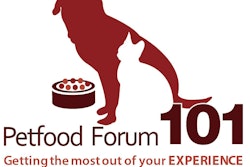
A wide variety of factors influence the procedures used in and results of pet food feeding trials. The duration and analysis used in a specific test depend on dog and cat food companies’ objectives, as well as the resources they can dedicate. While some pet nutrition scientists recommend longer trials and more extensive physiological analysis, pet food companies have shorter, less expensive options too.
“We perform a large number of different feeding trial protocols at Summit Ridge Farms,” Ryan Krupovich, director of operations at Summit Ridge Farms, said.
Those feeding trials range from days to years in duration and can include detailed tests on various health and metabolism indicators.
AAFCO and other long-term feeding trials on pet food
Association of American Feed Control Officials (AAFCO) feeding trials can range from 10-week growth tests to 6-month maintenance tests, Krupovich said.
Feeding trials that cover all life stages from gestation and lactation to growth vary in duration because of the breeding process involved with ensuring eight pregnant females.
Besides AAFCO tests, short-term feeding trials include:
- acceptability,
- palatability,
- stool quality,
- digestibility,
- urine pH,
- toy evaluation,
- litter testing and
- safety tests.
Typically, these tests last less than two weeks and often only a few of days, Krupovich said.
Long-term feeding trial types include:
- feline urinary tract health,
- weight loss;
- some efficacy studies,
- skin/hair coat and
- oral health/dental testing, which include the Veterinary Oral Health Council (VOHC).
At the extreme range of duration, Summit Ridge Farms has performed long term feeding trials with multigenerational evaluation out to three generations, Krupovich said.
Options for pet food feeding trial objectives
Detailed, long-term feeding trials may help pet food companies avoid nutrition-related crises, such as the U.S. Food and Drug Administration’s announcement about canine dilated cardiomyopathy’s correlation with certain grain-free dog foods. Then again, maybe not, since feeding trials might overlook breed-specific dietary needs and other factors, according to Jennifer A. Larsen, DVM, PhD, professor of clinical nutrition in the veterinary medicine program of the University of California – Davis.
“The use of feeding trials for nutritional adequacy is not as common as perhaps it should be,” Larsen said. “The AAFCO protocols, as outlined in the annual OP, outline minimum assessment parameters, but manufacturers can and should consider additional or more stringent procedures or testing. For example, the addition of plasma amino acid assessments might be useful, or protocols can be conducted for a longer period of time.”
However, both of those recommendations also increase the complexity and cost of feeding trials. While longer tests may provide insight into the long-term effects of specific formulations, in some cases a longer feeding trial may not be necessary to achieve the objectives of the test.
“We can do plasma amino acids and have had requests but they are not conducted routinely,” said Krupovich. “It is quite expensive and interpretation of the data is tenuous since our veterinarian does not believe there is a consensus of what are normal levels in dogs and cats. Also, there are a lot of amino acids you can test for so the question is which amino acids should be evaluated.”
Like the types of biological tests performed, a feeding trials’ duration depends on the goal of the test, along with other factors.
“AAFCO and VOHC protocols define the minimum duration of each test and there are certain industry standard tests where the minimum duration has been determined using sound historical data,” said Krupovich. “Another major factor in determining the duration of studies is the reason for running the test in the first place. Palatability for the purpose of evaluating ingredient and/or processing differences, may only take a couple days of feeding. Palatability tests for proving label claims or evaluation of food fatigue are usually customized for each individual circumstance and can typically last longer.”
However, to observe how a particular formulation affects dogs and cats over their lives feeding trials need to last month and longer.
“Studies that are conducted for evaluating a diet’s ability to ensure long term health are a minimum of six months in length or to determine adequacy of a particular nutrient often a minimum of 6 weeks,” Krupovich said.
Before a feeding trial begins, Krupovich and his team at Summit Ridge work with dog and cat food companies to determine their objectives. Then as the testing process continues, Summit Ridge works to achieve scientifically sound protocols, carried out in a technical environment, with data collected, analyzed and reported by experienced professionals, in the most cost effective manner to meet clients’ research needs, he said.

















